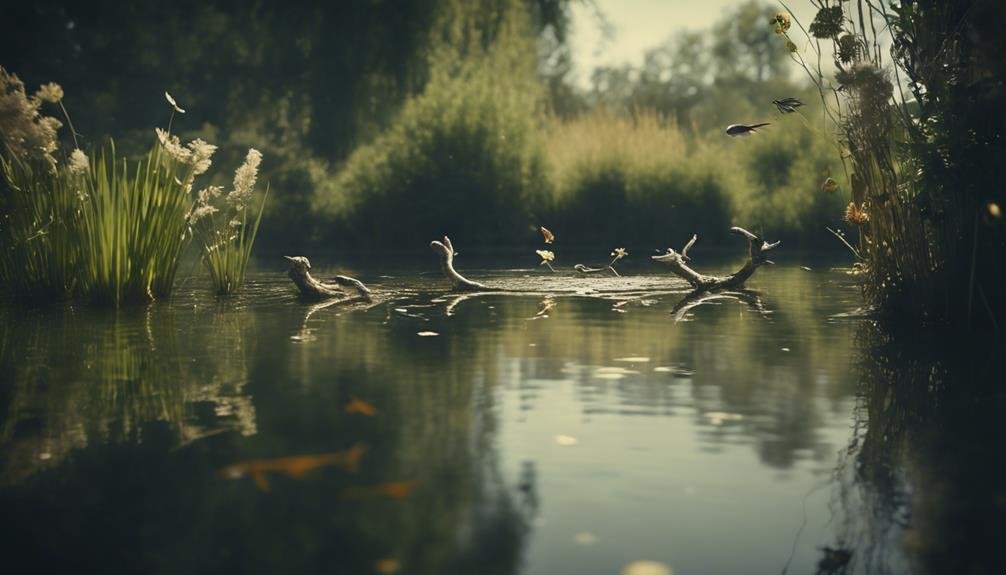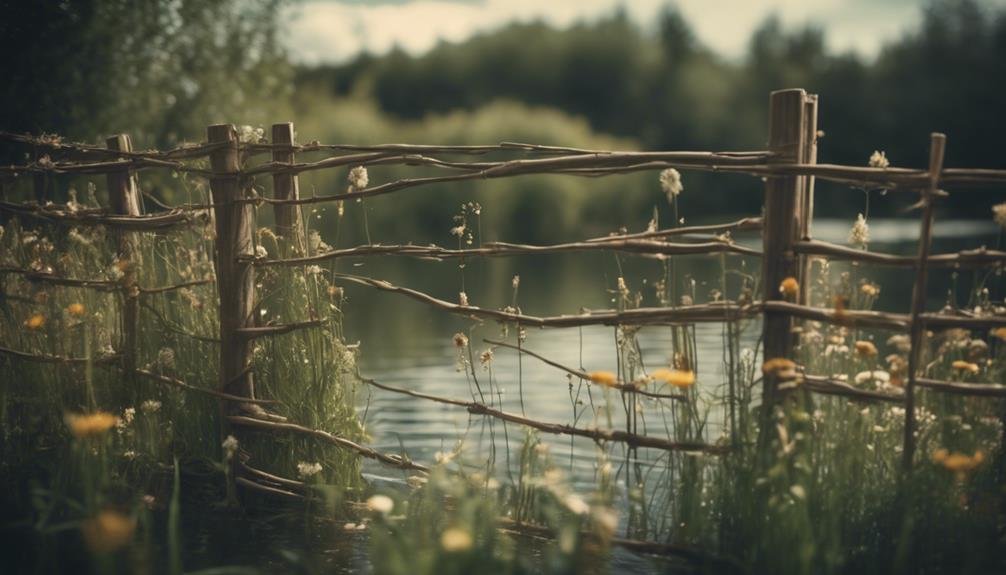To protect pond fish humanely, we will strategically plant barriers such as cattails and rushes around the pond's edge. These natural barriers serve as both a deterrent and a physical obstacle for predators.
Additionally, underwater fish havens made from materials like logs, rocks, or clay pots provide safe hiding spots for the fish. Aquatic plants like water lilies can also help by releasing compounds that are unpleasant to predators.
It's crucial to maintain proper oxygen levels in the pond, which can be achieved through the use of aerators, fountains, or waterfalls.
When it comes to fencing, it's important to choose eco-friendly options that are recommended by wildlife experts. This ensures that the fence not only protects the fish but also preserves the ecosystem.
By following these methods, pond owners can create a safe environment for their fish while also maintaining a balanced ecosystem.
For more detailed guidance on how to protect pond fish using humane methods, continue reading the following sections for in-depth insights and recommendations.
Strategic Plant Barriers
To ensure the safety of pond fish from potential predators, we can strategically plant aquatic greenery along the pond's perimeter, forming a natural barrier. These plants serve as a deterrent, making it more challenging for predators such as herons, raccoons, or snakes to reach the pond and its inhabitants. Optimal choices include tall, dense plants like cattails or rushes, which offer excellent cover and create an effective visual and physical barrier.
Placing these plants densely around the edges of the pond with a small opening for access establishes a protected zone where fish can swim and seek refuge securely. It's essential to select plants that thrive in the local climate and water conditions to ensure their growth and longevity. Regular maintenance, including trimming and replanting as necessary, will help sustain the plant barrier's effectiveness.
In addition to the perimeter barrier, floating plants like water lilies or lotus can enhance protection by providing extra cover and hiding spots for fish to evade predators. These natural defenses contribute to maintaining a healthy and secure environment for the pond's aquatic residents without resorting to harmful interventions.
Underwater Fish Havens
To safeguard pond fish from aquatic threats, underwater fish havens can be constructed to provide a safe refuge. These shelters offer protection from predators such as larger fish, turtles, or wading birds, allowing smaller fish to hide and rest securely.
One effective method involves sinking logs or hollow plant stems into the deepest part of the pond, creating crevices for fish to inhabit. Additionally, underwater caves can be formed by stacking rocks or submerging clay pots near the pond's edge.
Artificial fish havens made from dense plastic or wire mesh are another option to consider. These structures provide numerous hiding spots for fish to seek cover. When placing underwater havens, it's essential to ensure they don't obstruct water flow or pose a hazard to larger animals trying to exit the pond.
Properly positioned and maintained shelters can enhance the pond's ecosystem by offering a secure environment for fish to thrive.
Natural Predator Deterrents

In addition to building underwater fish havens, we can enhance the protection of pond fish by incorporating natural predator deterrents. One effective strategy is using plant life as a barrier against predators. Plants such as water lilies, cattails, and aquatic grasses offer dense vegetation that acts as a shield and hiding place for fish. These plants also release compounds that deter potential predators.
Water lilies provide excellent cover for fish due to their dense foliage. Cattails, with their thick growth, create a deterrent to predator access, making it harder for them to reach the fish. Peppermint is another useful plant that releases oils known to repel predators, offering an added layer of defense for pond fish.
Another beneficial approach is introducing natural predators of common pond predators. For example, dragonflies and their nymphs prey on mosquito larvae, which helps in reducing mosquito populations that can attract birds and other fish predators. Additionally, frogs play a vital role by consuming insects, slugs, and snails that could potentially harm pond fish.
Pond Aeration Techniques
Proper aeration is crucial for the well-being of pond fish, and there are various techniques we can use to achieve this. One effective method is to use an aerator or fountain pump to add air to the water, boosting oxygen levels and circulation.
Another option is to install a waterfall or stream feature, which naturally oxygenates the water as it flows and splashes. For larger ponds, a diffuser system that releases bubbles from the bottom can evenly distribute oxygen throughout the water column.
Maintaining adequate aeration is especially important in the hot summer months when oxygen levels can decrease significantly. It's also essential for ponds with a high density of fish or a lot of organic matter, as these factors can deplete oxygen more quickly.
Eco-Friendly Fencing Solutions

To properly maintain our ponds and protect them from external threats without harming the environment, installing fencing along the perimeter is a great eco-friendly solution. However, it's crucial to carefully select the fencing material and design to ensure minimal disruption to the natural ecosystem and wildlife.
Let's compare some common fencing options:
Wooden fences are a moderate eco-friendly and budget-friendly choice, but they may require more frequent replacement.
Vinyl fences are highly durable, environmentally friendly, but can be on the pricier side.
Metal fences are durable but have a lower eco-friendliness and can pose risks to wildlife.
When deciding on the best fencing option for our pond, we should consider our specific needs, budget, and commitment to sustainability. Seeking advice from local wildlife experts can help us make an informed decision that balances protecting our pond fish with preserving the surrounding ecosystem.
Humane Fish Handling
Handling pond fish with care is crucial for their wellbeing and health. It's important to be gentle when catching or moving them to reduce stress and prevent injuries. Using a soft, fine-mesh net can help avoid abrasions or scales being damaged. Keeping the fish submerged in pond water while handling them is essential to prevent gill damage from exposure to air. Limiting handling time and avoiding unnecessary touching can help minimize stress levels.
When transporting fish, using a well-insulated, aerated container filled with pond water will help maintain a stable environment for them.
When treating fish for illnesses or injuries, it's important to handle them with care during medication administration or procedures. Sometimes sedation may be needed to prevent further distress. Using proper handling tools such as soft nets, rubber-coated grips, and aerated holding tanks is crucial. Prioritizing the reduction of stress and discomfort is key.
Conclusion
Prevention is key when it comes to protecting pond fish. By implementing humane methods such as natural barriers, shelters, deterrents, aeration, and fencing, we can ensure the safety of our aquatic friends.
Proper handling techniques also play a crucial role in maintaining their well-being. These proactive measures not only safeguard the fish but also contribute to the overall health of the pond ecosystem, creating a thriving environment for all inhabitants.
By taking these steps, we can enjoy a harmonious balance in our pond and cherish the beauty of nature right in our own backyard.

